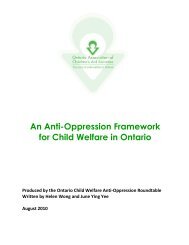English - Ontario Association of Children's Aid Societies
English - Ontario Association of Children's Aid Societies
English - Ontario Association of Children's Aid Societies
You also want an ePaper? Increase the reach of your titles
YUMPU automatically turns print PDFs into web optimized ePapers that Google loves.
C. THE CHANGING LANDSCAPE OF ABORIGINAL CHILD WELFARE IN<br />
ONTARIO<br />
THE FIVE YEAR REVIEW OF THE CFSA AND AN EMERGING NEW MODEL FOR CHILD<br />
WELFARE IN ONTARIO<br />
The Ministry <strong>of</strong> Children and Youth Services (MCYS) develops policy and administers<br />
programs and a service delivery system that is legislated by the Child and Family<br />
Services Act (CFSA). In 2010, the MCYS completed its five-year review <strong>of</strong> the CFSA and is in<br />
the process <strong>of</strong> developing strategies to address issues revealed by the review. A specific<br />
section <strong>of</strong> the final report reviewed the findings with respect to services to Aboriginal<br />
children and families.<br />
The review noted a number <strong>of</strong> challenges around Aboriginal child welfare in <strong>Ontario</strong>,<br />
including:<br />
> > The limited capacity <strong>of</strong> First Nations<br />
bands to respond and exercise their roles<br />
and responsibilities as set out by the CFSA,<br />
primarily due to lack <strong>of</strong> financial and<br />
human resources (MCYS, 2010)<br />
> > Subsection 2(2), paragraph 5 <strong>of</strong> the CFSA<br />
provides that one <strong>of</strong> the purposes <strong>of</strong> the<br />
Act, in addition to the paramount purposes,<br />
and so long as it is consistent with the<br />
paramount purposes, is: to recognize that<br />
Aboriginal peoples should be entitled to<br />
provide, wherever possible, their own child<br />
and family services and that all services to<br />
Aboriginal children and families should be<br />
provided in a manner that recognizes their<br />
culture, heritage and traditions and the<br />
concept <strong>of</strong> the extended family<br />
(OACAS, 2010b)<br />
> > Provincially, there is a lack <strong>of</strong> clarity with<br />
respect to the use <strong>of</strong> Customary Care<br />
as a permanency option for children<br />
involved with the child welfare system,<br />
notwithstanding the statutory obligation<br />
contained in Section 63.1, Part X<br />
(OACAS, 2010b)<br />
Despite provisions <strong>of</strong> the Child and<br />
Family Services Act that allow First<br />
Nations and Aboriginal communities<br />
to establish child welfare services and<br />
achieve designation to deliver child<br />
protection services, there are only six<br />
designated Aboriginal CASs in <strong>Ontario</strong>.<br />
The progress <strong>of</strong> devolution depends on<br />
government prioritizing this agenda and<br />
actively collaborating with Aboriginal<br />
communities. Aboriginal communities<br />
and advocates are the appropriate<br />
stakeholders to consult with to<br />
establish whether the barriers to<br />
progress are legislative, regulatory,<br />
financial or other. It is critical that<br />
government consult with the Aboriginal<br />
leadership to determine the appropriate<br />
course <strong>of</strong> action. - OACAS, 2010b<br />
135

















